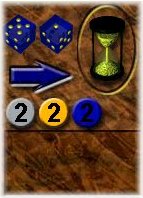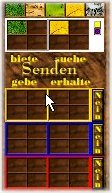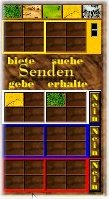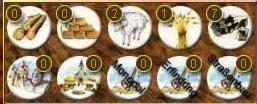Siedler von Catan
Game preparation
With /join can enter 3-4 players into the game. With /start the game begins. Alternatively, you can use the game management or use the buttons on the left in the picture.
The game
Since the settlers of Catan are widely used, this is not a complete game guide, but only a user manual for playing settlers here in the board game world. The knowledge of the rules is assumed. Prof. Easy is a good online policy statement.
The different menu areas
Tree

The possible construction projects are displayed in Baumenu. The number of remaining parts can be found under each field. If you travel with the mouse over a part, the raw materials required are displayed with a tool tip (in the image of the tool tip for a settlement).
If you are in the construction phase, you can select the desired part to be built and then place it on the field with a further mouse click.
Gamemenu with status display

Here you can see the cunning number of eyes, the "Next" arrow and the winning points of each player.
Additional information about the number of raw material and special cards held on the hand, as well as the number of played knight cards, can be obtained by clicking on the score of the respective player. Here you can also see the "Last Road" and the "Größte Rittermacht". A click on the dice shows the dice statistics.
The oval game phase display provides information on which phase you are currently in.

A co-player is in line, you have to wait yourself.

Use a settlement.

Use a road.
These two phases are at the beginning of the game, the latter also during the playing out of the special map "Strassenbau".

You yourself are in the exchange phase. Here you can exchange with all opponents, bank or port.

The opponent is in the exchange phase, you can act with him.

It is in the construction phase.

A seven was thrown and you had more than seven cards on your hand. That is why half of his cards (rounded). Click on the corresponding raw materials in the raw material display.

You stabbed a seven or played a knight card. Now you set the predator by clicking on the desired raw material field.

Once the robber has been set, one can steal a raw material map from a settlement/city bordering this raw material field. To do this you simply click on the desired settlement/city.
Exchange indicator

In the exchange display, the active player can enter his exchange offers at the top. To do this, he selects the raw material he wants to offer and clicks to the "off" field on the left. Click again adds the same raw material. He then selects the raw material he wants to have and clicks right into the "search" field. By clicking on "Send" the offer will be sent and the players can see it.
Here in the example, the player wants to make a wood and want a grain for it.
Players who want to reject the offer click on the "No" button next to their exchange box. In addition to its field, the active player then receives the negative feedback in the form of the smeared color field in the color of the player who rejected it.
NEW: The current exchange offer is displayed in the corners of the field. A trade can be rejected there by clicking a short one (adapt). Then finally accept the trade with a LANGEN click (add and hold down).

If a player wants to enter the offer, he clicks on the raw materials offered in his raw material field.
NEW: If you want to enter the offer you have to trigger this by clicking on a LANGEN (top and hold something down).

The active player will see acceptance of the offer by a small colored square next to its raw material field.
In the example, the blue player agreed to the offer.
At the end of the transaction, the active player now clicks on the colored square and the raw materials are exchanged.
The exchange at a port (3:1 or 2:1) or with the bank (4:1) function analogously; in this case it is automatically recognized whether a exchange is possible at the desired conditions. For example, if you have a 2:1 port, the two raw materials to be dispensed are placed on the biete side and the desired raw material is placed on the search side. By clicking on "Send" the exchange is executed.
Handcard display

In the handcard display you can see all your handcards. In the upper row, the raw materials are listed, including the special cards. The number in the circle indicates the number of cards presently present on the hand.
If you want to play one of the special cards, just click on them. It should be noted that tickets purchased in the same round can be used at the earliest in the next round.
Knight cards
The knight card is clicked during his turn to play a knight. The corresponding symbol appears in the status display and you can place the knight on the field and steal a raw material (see above).
Siegpunk card
The victory point card is not played, it remains invisible in hand for the fellow players. Of course, it is not counted in the victory point indicator. However, the system automatically detects the card.
monopoly
With the monopoly card, all players are allowed a Steal variety. To do this, the desired raw material is entered in the own raw material field under "search" and click on "Send"
In accordance with the invention,
With the invention card, two raw materials may be selected. Once the card has been selected, you click the desired raw materials into your own "search" field and send them off.
Road transport
If you choose the road map, then the status indicator changes to "Building Street" and you can now use two streets on the field for free
Game sequence

Reihum first put all players a settlement and a street. To do this, you simply click on the desired intersection or Field border where you want the settlement/street. Once every player has set, the whole thing is repeated again in the opposite direction.
If the blue arrow lights, you are on the row. It is now first in the exchange phase and can act with its fellow players (see above). To end the exchange phase, click again on the blue arrow and thus enter the construction phase. Here you can build settlements, streets and cities or buy development maps (see Baumenu). If you want to finish your turn, click on the blue arrow. This ends the train and at the same time dices for the next player.
Playing
The game ends as soon as a player has reached ten win points.
Options
Turning
At the beginning a settlement with a street will be set, then a city with a road. Then each player sets a road again.
ritter
The field blocked by the knight must not be built.

